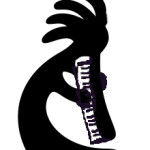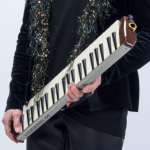Tuning Standard
Tagged: tuning
- This topic has 31 replies, 8 voices, and was last updated 8 years, 8 months ago by
 Melodica-Me.
Melodica-Me.
-
AuthorPosts
-
March 11, 2014 at 7:18 pm #1967
 Alan BrintonParticipant
Alan BrintonParticipantWhen I first started tuning my melodicas, before I saw the tutorial on this site, I got most of my information from harmonica sites where the standard appeared to be A=443. Since my melodicas were all mostly sharp, I got the impression that they were factory tuned (though not very well) to A=443. Further inquiry revealed that symphony orchestras tune to A=443. Gearing up as I was to play with symphony orchestras (humor alert), I adopted this as my standard. (I understand that playing a harmonica or melodica loud flattens the notes somewhat, which is a reason to tune slightly sharp, though I usually don’t play loud.) I’m aware that the recommendation in the excellent melodicaworld tutorial is A=440, 442 if you play loudly.
I am in the process of tuning my Yamaha P-25F, whose tuning I had not previously measured but that had seemed off to me. I now realize that it seemed off because my P-25F came tuned flatter than my other melodicas. Almost every note was flat relative to an A=443 standard; so it didn’t sound right to my A-443 attuned ear. Consequently, I’m tuning it up, though closer to 442 than to 443.
What really matters for my purposes is, of course, having the melodica in tune with itself and working reasonably well with Band-in-a-Box accompaniment, since I don’t expect to be performing with real musicians. But I am curious to hear what the real musicians here think about the tuning standard for melodica and harmonica, chromatic harmonica in particular.
March 17, 2014 at 7:04 pm #1986 KevinParticipant
KevinParticipantAlan,
I’m probably going against the prevailing thoughts here but I’m in favor of A=440.
That’s been a standard for a long time. If you buy any electronic keyboard or other fixed pitch instrument it’s going to be tuned at concert pitch A=440.
I don’t get the tuning the reed high so that when playing it comes down in pitch? People must be playing much louder than I ever have? :-O
If you buy a pitch pipe which works on the same principle of a harmonica you expect it to be tuned to A=440. It doesn’t say in the directions blow as hard as possible to bring the pitch down to correct tuning!
I think this is one of the main offenses that keep the melodica from being taken seriously. It’s usually the last straw.
They see you pull out this instrument that’s plastic with child-size keys and if they have seen one often it’s associated with children or music education. You get a few jibes and chuckles but then the music starts and after a chorus or two of you being obviously out of tune with every other instrument in the band and no way to tune on the fly you are “politely” asked to put that thing down and get back behind the piano!March 17, 2014 at 7:42 pm #1987 Alan BrintonParticipant
Alan BrintonParticipantThanks for responding, Kevin! Your arguments have some weight and raise precisely the kinds of issues I’m interested in having discussed. I have a Kurzweil Mark-Pro Two electric keyboard, which is clearly a professional level instrument. I just checked its tuning with my gStrings app, and it comes in at A=441.3. I don’t have the owner’s manual handy, but I’d be surprised if it can’t be calibrated, probably by any schmo. Its only previous owner is a Jazz pianist who I’m quite sure didn’t re-calibrate it. Bosendorfers are factory tuned to A=443 (or to order). Some people claim that slightly sharp tuning of certain instruments enhances the sound of a small group when set off against standard tuning of the other instruments. I’m just inquiring here, though, and don’t have a strong opinion one way or the other. The question here is about what works best for the melodica.
I know that standard concert pitch is A=440, but only sort of, since it varies somewhat by country and between different orchestras, and the standard has been debated and has varied over time.
March 18, 2014 at 12:20 am #1988 Melodica-MeParticipant
Melodica-MeParticipantMost professional keyboards have onboard tuning, I have a Kurzweil PC-88 controller that I use as my main keyboard that controls other sound modules, this one can be tuned through the display panel, very easy, and I always check the tuning before I record and make sure is is to A-440. If your keyboard is a home use digital piano, this feature may be a factory fix, But Kurzweil keyboards usually have onboard tuning. I recently had my Vibrandoneon serviced and I had them tune it to A-440. In an accordion, they sometimes tune them a bit higher because the bellows can push a lot of air at once if needed and will detune some notes, but again the melodica is not an accordion. I have to agree with Kevin, that if you walk into a session whip out your melodica and are out of tune with the other musician and can’t adjust your tuning, you are going to loose a lot of credibility pretty quick. You have to know how your instrument works best and practice dynamics. also a 99 cent apps for your I-pad or I-phone are not going to be as accurate as a regular chromatic tuner. Invest in a decent one if you are going to tune your melodicas by yourself.
Melodica-MeMarch 18, 2014 at 3:14 am #1989 Alan BrintonParticipant
Alan BrintonParticipantAlthough lots of musicians post reviews saying gStrings and some other tuner apps are accurate, I have wondered if it’s worth purchasing a dedicated tuner. Are you thinking of something like the Korg TM50BK, Melodica-Me? Or are we talking about something much more expensive?
It is clear to me that I am able to significantly improve the tuning of my melodicas using gStrings Tuner, and I believe the same would be true even if I were simply tuning by ear with a tuning fork or from my electric keyboard or recently tuned Yamaha piano. I’m a real duffer on guitar, but it’s not pointless to tune my own guitar, even if it’s just by ear. So I have to disagree with the judgment that it’s not worth doing your own tuning unless you have state-of-the-art equipment, just as it’s silly to say that it’s not worth playing an instrument unless you’re a professional.
March 18, 2014 at 4:04 am #1990 Melodica-MeParticipant
Melodica-MeParticipantAllen, No not at all, I don’t think you need an expensive tuner, but it should be a chromatic tuner. With multiple octaves so you can tune A3 @ 220 A4 @ 440 A5 @ 880 and so on. You may want to vary the intonation between octaves, sometimes it sounds a little thicker than right at the proper vibrations. Tuning a guitar by ear no sweat, tuning a piano with harmonics is talent. My first tuner was a Conn strobe tuner that I used to tune my Fender Rhodes, it was a work horse for years then one day it was off and even after servicing it, it was never the same. A pro tuner cost thousands I’m talking a korg cromatic with a VU type meter and not a LED type light. Much easier to use.
Melodica-meMarch 18, 2014 at 10:56 am #1991 Alan BrintonParticipant
Alan BrintonParticipantgStrings is a chromatic tuner with a VU type meter, Melodica-Me. I’m with you on the type of meter. I’ll get one of the Korgs and see how it compares. I don’t think the cost of an app means much. The hardware I’m using is a $500 tablet computer, and we know that a lot of the best operating systems, software programs, and applications are free. Linux operating systems, for example. Fortunately, a lot of developers are not in it for the money.
I take your opinion about 440 vs. 443 very seriously given your background. For my purposes, it doesn’t matter much, since I’ll never be pulling out my P-32D melodion or a Bosendorfer on a gig. But, unless my readings on a bunch of melodicas are way off, almost all of them come factory tuned closer to A=443 than to A=440. I have no vintage melodicas so don’t know whether the same applies to them. But if the standard for performance is 440, then there’s a lot of tuning to be done, especially if the emphasis is on establishing the melodica as a respectable instrument. Everyone who’s using melodicas on gigs needs to get their melodicas down there, either by learning to tune or by contracting the job out to a professional.
Complete tuning to A=440 (or whatever) is a challenging project. But bringing a handful of your flattest and sharpest keys roughly into tune with the rest of the keyboard isn’t, and that’s the sense in which an ordinary schmo like me can tune his own melodica.
March 18, 2014 at 1:27 pm #1994 DarenKeymaster
DarenKeymasterA few of my thoughts on concert pitch – modern concert orchestras currently tune to A=440, A=442 and A=443. Soloists with orchestras often tune slightly higher than the orchestra they are playing with, to enable them to stand out.
An orchestra has an advantage in recording slightly higher than its competitors. When auditioning tracks, side by side in iTunes, the higher track sounds more brilliant and impressive.
Harmonicas are often tuned slightly higher than A=440, because in performance, notes often become flatter when played loudly. Same principe with melodicas.
There’s also the question of wether you want to tune your melodica to ‘equal temperament’ (equally spaced intervals, like a piano), or ‘just intonation’ (a more natural, consonant sound). Of course, with ‘just intonation’ you’re limited to specific keys, but the pay off is a more harmonious sound. This is something I plan to experiment with…
But at the end of the day, it’s whatever you’re happy with to suit your playing style, and the sound you want to achieve. Nothing quite beats the feeling of turning up to a music session with a freshly tuned melodica!
March 18, 2014 at 3:23 pm #1995 Alan BrintonParticipant
Alan BrintonParticipantThat helps make sense of some orchestras and Bosendorfer factory tuning to A=443, and also of the historical drift up in the past. Thanks, everyone, for the comments. It’s all helpful. I’ll drop the assumption that A=443 is the standard for melodicas and see what seems right for me for the particular instrument.
March 25, 2014 at 5:33 pm #2001 barbParticipant
barbParticipantI agree that having a melodica in tune with your ensemble is one way to gain respect and acceptance of this incredibly versatile instrument. I’ve been performing with classical music ensembles, and at first the audience isn’t quite sure about the instrument when they see it. Until they hear it. Then they almost like it as much as I do.
For my purposes, 440 or 441 is necessary; I also play with a vibes player whose vibes are sharper than that, so I’ve tuned one of my melodicas higher for that purpose. It’s easy enough for my to tune my electronic keyboard to any of my melodicas.
I usually tune keyboards (small acoustic organ and harpsichord) by ear, because I don’t tune equal temperament for my gigs. (I mainly play Baroque music, where there were lots of good sounding temperaments being used that are easily tuned by ear). I also use a Korg master tuner VU meter (discontinued) which is programmable to different temperaments, so I can store temperaments from when I play in ensembles with bagpipes, or Cambodian instruments. One of my goals is to have a melodica at 1/6 comma meantone which restricts the keys I can play in (to about 8), but sounds incredible when playing chords.
I will be having lots of time in the next weeks to devote for tuning my melodicas; so far I have found that tuning to a meter visually actually leads to different results than when I tune by ear to the pitch made by that electronic tuner. I suspect it has something to do with things mentioned in this article (are we allowed to post links?); the crux being that frequency and pitch are NOT the same thing, and results you get by looking at a dial are not the same as what the brain makes out of the information coming in through the ears.
http://www.scielo.br/scielo.php?script=sci_arttext&pid=S1806-11172012000200004
i don’t pretend to understand everything in this article! But as you can tell, I’m a tuning geek. Probably due to tuning and playing organs and harpsichords, which you tune every rehearsal and gig, are easily tuned and have to play chords. Melody playing I am not so picky. But my dream is to have a melodica ensemble (any takers in the western NC area?) and then we would have to be in tune for chordal playingMarch 25, 2014 at 6:12 pm #2002 Alan BrintonParticipant
Alan BrintonParticipantThanks so much for your insights, beezer. Your eclectic tastes in what you play are really valuable for a discussion such as this. I was persuaded by the comments of Kevin, Melodica-Me and Troy that I should probably be tuning to 440 or 441 rather than 443. So I spent the entire day yesterday tuning my Suzuki M-32C, which I’ve been playing a lot lately, to A=440, getting simultaneous readings from AP Tuner on my PC and da-Tuner on my tablet. I also did some checking with Tunable, which has a line graph on which you can see that you’re producing a stable tone. At any given instant, these tuners and gStrings Tuner get comparable readings. I then played several Jazz tunes with Band-in-a-Box accompaniment, and I have to say that the M-32C sounds much better at A=440 tuning than at 442 or 443 — I’ve been experimenting with this melodica. I was tuning to get within 3 cents +/-.
I’m curious as to how accurate you try to get with your melodica tuning. I’m not sure I can do much better than 3 cents +/- verified (more or less) within those parameters by subsequent readings. Also, are you familiar with the Adaptive Pitch Test at jakemandell.com? It just takes about ten minutes to complete and measures how reliably you can recognize which of two tones is higher or lower. After completion it, you are given results for all who have already taken the test.
Thanks for the article link. I’ll see how much sense I can make of it!
March 25, 2014 at 9:00 pm #2003 barbParticipant
barbParticipantI’m curious about the tools you use for tuning, Alan. I have a curved file from melodica.com. Have you ever needed to replace a gasket? I’m a little afraid of stripping the screws and wrecking a gasket
I took the adaptive pitch test – 1.425Hz. I noticed many tuners are accurate to =/- 1 cent. Anything under 5 cents I leave alone – I am not as experienced with melodica tuning as Alan, or as one of my students who tunes often. I find that some of my instruments read differently on my tuner from day to day! so have become more conservative about tuning reeds – often just tune the worst offenders til they are almost acceptable.March 25, 2014 at 9:45 pm #2004 Alan BrintonParticipant
Alan BrintonParticipantMy tuning kit is primitive: a $9 set of 10 curved needle files like the melodica.com one from Amazon.com; a 3/8″ strip cut from the end of a business card, folded at 5/8″; and a plastic toothpick. I picked out some of the pointed files that looked best for the process, and I do some filing at the curve of the file and some scraping with the edge. I also have a couple of sets of precision screwdrivers from Delcast and Goldtool. Stripping the screw head is pretty easy to do, but I don’t think finding replacement screws would be a problem. Stripping threads in the plastic is more of a worry. The better quality Suzukis have metal nut inserts, so the only worry there is having them fall out and be lost. Although I’ve been experimenting off and on with tuning for about two years and am comfortable with the physical process, I’d be reluctant to tune anyone else’s melodica unless they just wanted a few really flat or sharp keys improved. I don’t know if I have a good enough ear for serious tuning.
Getting inconsistent readings is a serious problem, more so with some melodicas than with others. It seems like on one and the same melodica, I get very stable readings on one day and inconsistent ones on another. (The weather?) I have lots of time and lots of melodicas, so I’ve been able to experiment. This may be partly psychological, but I’ve been finding that if I blow really hard a couple of times on a note (flattening it) just before tuning, I’m able to get more stable readings. It also seems to help to alternate the note with a higher and a lower note as a way of stabilizing the reading.
The article is very interesting, even though my understanding is not very complete. It’s quite clear from the article that there’s a whole lot more to tuning than I’ll ever understand. I just noticed that AP Tuner actually has the option of choosing a stretch table, though only for a few types of pianos and guitars. Do you suppose it would be possible to develop a stretch table for the melodica? And/or a tuner? Have you seen Dirk’s tuner software for accordions and other free reed instruments? It’s very expensive.
March 26, 2014 at 12:23 am #2005 barbParticipant
barbParticipantI’m going to try the hard blast of air before tuning, and playing other notes before taking the reading.
My first thought is that melodicas don’t have enough octaves for stretching to be an issue; also when not playing chords it’s not an issueMarch 26, 2014 at 12:47 am #2006 Alan BrintonParticipant
Alan BrintonParticipantThat would be good news if it doesn’t matter for melodicas!
I play the other notes while taking readings, going back and forth and then intermittently sustaining the note. Kirk’s software also allows for tuning in relation to chords, though I didn’t really understand what that means. I also read that smaller gaps can be perceived when there’s a harmonic context.
-
AuthorPosts
- You must be logged in to reply to this topic.
